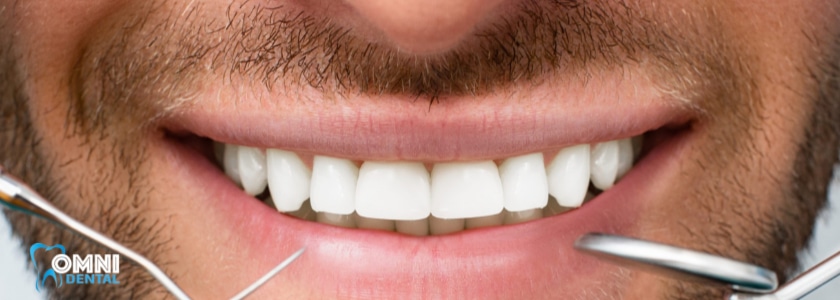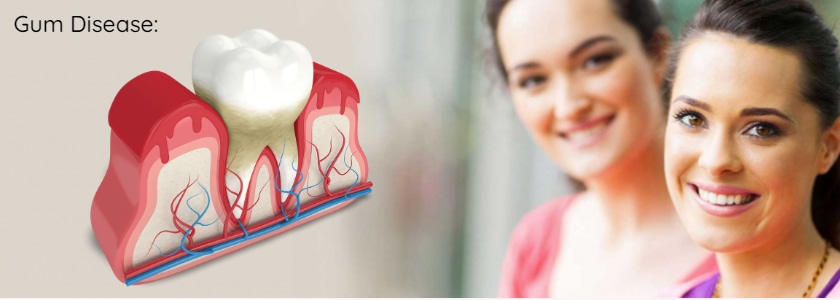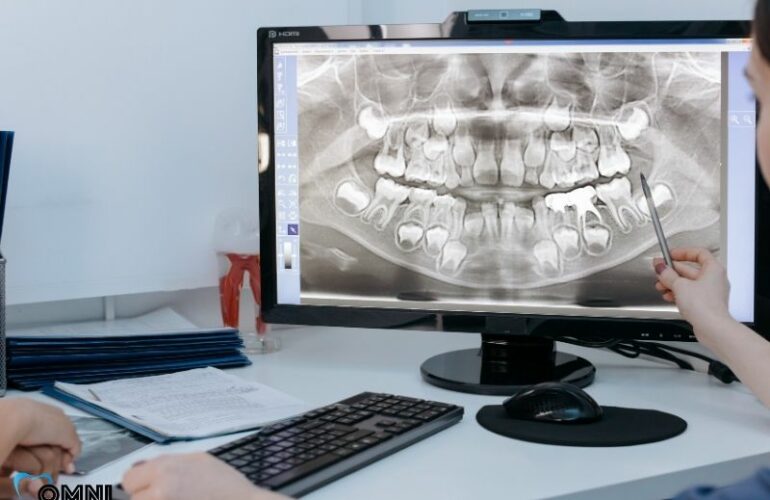Gum disease first affects the gums, but can harm the teeth and jaw bone if left to advance without treatment. Our treatment process includes removing all traces of bacteria and diseased gum tissue. If needed, we will contour the jaw bone to encourage reattachment of the healthy gum tissue, lessening the depth of the pockets around the tooth roots where bacteria thrive. Traditional osseous surgery, a time-tested gum disease treatment method, can effectively bring health back to the gums. Many patients, however, choose laser gum therapy as a minimally invasive alternative. Laser dentistry poses many benefits for patients, especially those with dental anxiety or fear. Laser technology allows us to treat many periodontal concerns with greater precision and comfort for you, without the need for scalpels and incisions of traditional surgery.
What is Periodontal Disease?
Periodontal Disease, also known as Gum Disease, is one of the most common dental health issues in America affecting more than half of the population. Proper periodontal care helps you to prevent, halt, and treat Gum Diseases caused by oral bacteria proliferating in space between tooth and gum that may infect and damage gums.
Effective Gum Disease Treatment
The treatment we choose will depend on the extent of gum disease present. If we can catch gum disease in its earliest stages, a professional cleaning with our hygienist may be all that is needed to remove bacteria and halt progress of the disease.
For more severe cases of gum disease, a deep cleaning will be needed to completely remove the bacteria and infected tissue. During a deep cleaning, our hygienist will use ultrasonic and hand instruments to clear away tartar, plaque, and bacteria around the gum line. To ensure your complete comfort, our hygienist will use Oraquix, a locally delivered anesthetic.
If your periodontal disease has progressed to an advanced stage, gum surgery may be needed. Dr. Huang works with specialists with extra training and experience in this area, and he will be happy to refer you for treatment.
What Is Scaling and Root Planing?
A two-step procedure, the deep cleaning is known as scaling teeth, and root planing might take more than one appointment. To minimize any discomfort, you might need a local anesthetic.
The goal is to thoroughly scale all plaque, bacterial toxins, and tartar deposits from your teeth and root surfaces.
If caught in the earliest stage of gingivitis, when damage below the gum line has not yet occurred, gum disease can be effectively treated with scaling and root planing. This deep cleaning begins with “scaling” the teeth to remove the plaque and tartar that has built up both above and below the gum line. Next, “root planing” smooths the rough surface of the tooth root to help the gums reattach.
The Importance of Eliminating Gum Disease
Gum disease is not just a problem that affects your oral care. Recent studies have revealed a connection between chronic diseases of the mouth and your overall health. This research suggests that periodontal disease can increase your risk for heart disease, stroke, miscarriage, and diabetes, among other conditions.
You can easily eliminate the risk of these complications by following a simple routine of preventive treatments that include regular exams and professional dental cleanings with our gentle and skilled dental hygienist. This allows us to monitor your situation so that we can catch gum disease in its earliest stages and treat it before it causes serious problems that are more complicated and costly to resolve.
Step One: Scaling
Dental scaling dives deeper into the gumline with manual hand instruments, ultrasonic instruments, or both.
If your hygienist – or dentist – uses an ultrasonic scaling device, sonic vibrations will remove the plaque bacteria and tartar (calculus) from the tooth surface and underneath the gumline.
A manual dental scaler can do the same thing. Or it can supplement the ultrasonic device by removing particles the device can’t break loose.
Step Two: Root Planing
Root planing involves an even deeper dive with detailed scaling of the root surface to smooth out rough areas.
Smooth root surfaces keep bacteria, plaque, and tartar from re-adhering underneath the gumline. Root planing decreases gum tissue inflammation, allowing your gums to heal and reattach themselves more firmly to your teeth.
If needed to prevent infection, your dentist may recommend medicine directly into the area undergoing the procedure.
After your deep cleaning, you’ll need to schedule a follow-up visit with your dentist.
How do I know if I Have Gum Disease?
The American Dental Association has reported that Roughly 42 percent of all dentate U.S. adults 30 years of age or older have periodontitis; evaluation by dental professionals will help you find out if you’re one of them! Early gum disease may not be obvious to you, but common symptoms may include swollen or bleeding gums, bad breath, loose teeth, or dark buildup between teeth and gums. How is gum disease treated?
Dr. Bilus will evaluate your gum health and help you choose the proper treatment. Mild gum disease, known as gingivitis can be treated and even reversed with regular routine cleanings. The longer you may have gone without addressing the condition, the harder we may have to work to treat it, but we have the techniques and expertise to do so and get you healthy again. More advanced periodontal disease may call for scaling and root planning with more regular maintenance visits. In some cases, a laser may be used, or an antibiotic therapy called ARESTIN™, which eradicates the bacteria that cause gum disease. And it works painlessly!
Is Periodontal Disease The Same As Gum Disease?
Yes, periodontal disease is just another name for gum disease. They both refer to the inflammation and infection of gum tissue caused by oral bacteria. Gum disease can seem relatively minor at first—in fact, if you don’t visit the dentist regularly, you might miss the warning signs at home until it has already become severe. When periodontal disease is left untreated, however, it worsens and can eventually lead to major health concerns including gum recession, bone loss, and tooth loss.
How to Keep Your Gums and Teeth Healthy
Brushing and flossing your teeth isn’t hard to do. And doing both correctly can help prevent gum disease and tooth loss.
Gum disease is caused by bacteria found in plaque and tartar. Plaque is a sticky film that forms on the teeth. It is mostly made up of bacteria, mucus, food, and other particles. When plaque isn’t removed, it hardens into tartar, which gives a home to bacteria, according to the American Dental Association (ADA). Bacteria in plaque and tartar cause inflammation of the gums, called gingivitis. Tartar can only be removed by a dental hygienist or dentist.
Gum Disease Laser Treatment?
Lasers are considered leading-edge treatment for periodontal disease. Advantages of laser treatment include:
- Enhanced success
- Reduced anxiety in patients
- Eliminated drill noise and noisy ultrasonic instruments
- Limits bleeding
- Minimizes risk of bacterial infection
- Preserves healthy parts of the teeth
- Sealed periodontal pockets
- Reduced gum trauma
- Minimized swelling during treatment
- Faster healing time
- Can be optimized for patients
Care For The Whole Family
Dr. Bilus has provided care for generations of families. We hope you will choose us as your family dental office and we look forward to meeting you. Call our office today or fill out the form to schedule a checkup with Omni dental of Arlington Heights IL.







